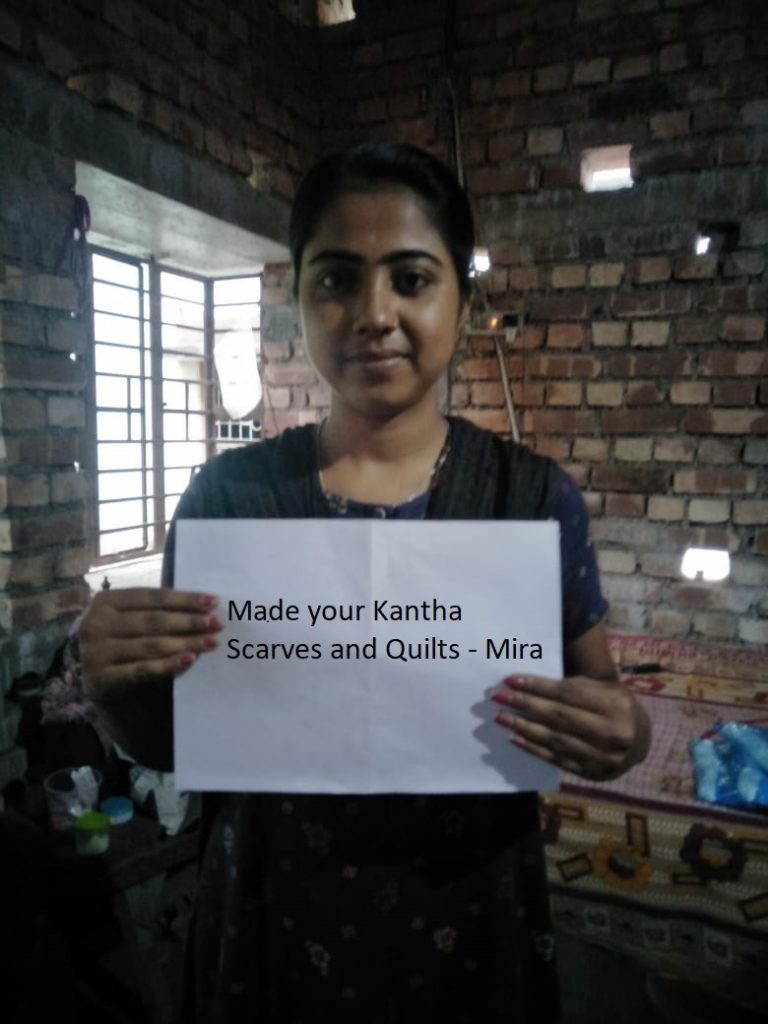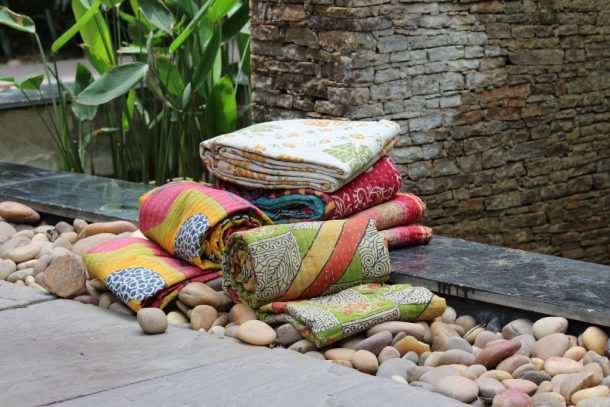Meet Our Artisans
Who Proudly made your Kantha’s

Mira
Based in Bengal
I feel proud seeing people loving Kantha to this extent. It takes too much efforts to stitch one piece.

Makki
mirpur village, bengal
We, women in bengal work altogether to stitch these pieces. This is our source of livelihood.

Misha
BENGALI
I like to stitch Bohemian Pattern because i feel connectivity in it.It takes 1 month to stitch such.

HIRA
BASED IN MIRPUR
I love Babies, their little hands, feets….So i love Quilting for Babies.
ARTISANS STORY
Kantha embroidery, native to West Bengal, continues to be the dominant textile art and craft of the state. Specialist artisans of the art of Kantha embroidery are mostly female as it originated as a household craft amongst rural families, with techniques passed down from mother to daughter. It is still broadly practised in the homes of millions of West Bengali rural women who inhabit in villages in the districts of Hooghly, Burdwan, Murshidabad, North and South 24 Parganas and Birbhum.
For both local and tourists, the most prominent location for the production and purchase of Kantha embroidery, particularly the Kantha saree and Nakshi Kantha quilt is Bolpur-Shantiniketan, also simply known as Bolpur, located in the district of Birbhum of West Bengal. Mainly Muslim population of West Bengal chiefly resides in Murshidabad, which is the mid location for Muslim Kantha embroidery that feature geometric motifs.
Whilst Kantha embroidery is at its crest of popularity and has been practised by the rural women of West Bengal for over five centuries, remembrance of its elaborate craftsmanship reduced over the years. Improvement of the craft in West Bengal can be attributed to three key periods and organisations.
Throughout the course of the freedom movement of the 1920s, Sushen Mukherjee founded the Amar Kutir Society for Rural Development, or simply Amar Kutir, in the Birbhum district to sustain the livelihood of traditional West Bengali arts and crafts and its artisans. Amar Kutir remains an artisan hub for Kantha embroidery amongst many other native crafts, including batik.
During my trip to Bengal I met many of these artisans which are involved in Kantha handwork. Many of these artisans were very shy and disinclined to be in the spotlight. For them, It’s not something they’re used to. It is something like a stranger suddenly turning up at their village wanting to take lots of pictures and video would be a bit stupendous!
However, Our artisan Mira – Changed the original identity, (although a little shy at the beginning), came across and we had discussed a lot about Kantha and their work.
Mira’s life – “ I’ve worked here for more than 10 years and I appreciate it a lot.
I work here for 5 hours a day and then go home, cook food and look after the family. We are 5 members. All are very supportive. I am also allowed to give extra time to my work in case of priority order.”
On asking How she feels earning money by working on own? – She smiled and said –
“ I am very happy and more satisfied working and earning money. Now I can save for children education. I am not dependent anymore.”
How do you feel by working for this women’s cooperative?
I feel empowered; working in a group of all women means we can share our problems. As we all are of same village, we know each other very well and are very comfortable while working late hours. We help each other during tough times and I am happy that we all are together to show our craftsmanship to the whole world.
How do you feel when your hand-stitched kantha goes overseas?
It gives me immense pleasure that by having my involvement in preserving traditional Indian textile crafts such as Kantha.
The other one was Makki whom we met:
Being a Bengali, there was a brawny natural affinity and pride to start with crafts from my home-state. Why I chose crafted products is tough to answer. I myself is quite influenced with this embroidery and products made from it as they bring a unique appeal with a touch of history.
I cannot deny my mother’s impact on me as she has been an avid craftswoman herself all her adult life. I remember visiting fairs in different cities along with my mother and stare at the products on display. Perhaps all those visits have had a fancy strong enough to ignite an entrepreneurial spark in me much later in life. Now I own a small group of women who make these kantha products to ship overseas. I am now quit confident to let people know of Bengal art.
On asking her views about Kantha Embroidery, she replied –
Kantha embroidery is popularly a woman-oriented recreation originating from rural Bengal. The place where I work has many women artisans who love their embroidery. This Kantha embroidery is a temper for these women.
Hand embroidery is extremely labour intensive and time consuming. We determine on the base color of the fabric and the embroidery thread colours before the work is issued. The process begins with detailed designs and intricate motifs sketched on tracing paper before being transferred onto the base fabric.
An inherent motif of Kantha work is real life incidents imprinted on a piece of cloth. Other themes comprises of folk tradition, animals, birds, floral motifs, tribal designs, geometrical shapes that matches with the elated feel of Bengali community.
Please be noted – we have not used real name of our artisans to not to show their identity.

